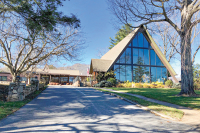EXCLUSIVE: Potential property shuffle puts Haywood County Schools in a pickle
 The Crawford parcel off Ratcliff Cove Road, shown here in yellow, is just south of the Francis Farm landfill.
Haywood GIS photo
The Crawford parcel off Ratcliff Cove Road, shown here in yellow, is just south of the Francis Farm landfill.
Haywood GIS photo
A relatively routine rezoning request for a parcel off Ratcliff Cove Road has inadvertently revealed multi-million dollar plans by Haywood County Schools to consolidate several of its auxiliary services in one central location — a move that could affect multiple facilities and have a ripple effect on several other ongoing county issues.
“We’re thinking long-term,” said Chuck Francis, longtime chairman of the Haywood County School Board. “It would help centralize a lot of our facilities and benefit more than just the school system.”
During a special called meeting of the Waynesville Planning Board on April 26, board members heard a map amendment request for 237 Ratcliff Cove Road, owned since 1997 by Michael and Deborah Crawford.
The Crawfords have an agreement to sell the 29-acre parcel to the Haywood County Board of Education. The sale is contingent on the rezoning request’s approval by the town of Waynesville.
Right now, the parcel is located in the Raccoon Creek Neighborhood Residential District, which calls for low- to medium-density residential development only. The requested change would create a mixed-use overlay, which would allow for certain other uses.
Those other uses include live-work units, financial and business support services, laundry services, funeral homes, personal services, general commercial establishments of less than 100,000 square feet, gas stations, restaurants and government services.
Related Items
Patrick Bradshaw, of Asheville-based Civil Design Concepts, presented preliminary drawings of a proposed facility that would incorporate four separate school support operations that are currently strewn about the county into one facility.
The first is the school bus garage and maintenance facility currently located at the former Francis Farm landfill. According to Graham Haynes, assistant superintendent for auxiliary services, the impetus behind leaving that facility is that Haywood County government has qualified for state and local grants which will transform the site into a pump track for bicycles.
Then, there’s the system’s food and nutrition services, currently located at an old school building in the Crabtree community.
Perhaps most important is the school system’s information technology department, presently located on the banks of the Pigeon River in Clyde. The facility has flooded before, and will again. The Board of Education also meets on that same site in Clyde and hosts trainings there, so its operations would move to Ratcliff Cove as well.
On April 17, legislators including House Majority Leader John Bell toured the site in Clyde with Haywood Republican Rep. Mark Pless to see firsthand the challenges in maintaining the facilities there.
Pless has been adamant about getting the school system’s operations away from the river, even though the IT department has ready access to high-speed internet there.
He said he’s seeking $20 million from the General Assembly for a replacement for Central Haywood High School, which also occupies part of the site in Clyde, but he’s not been asked for any money for the consolidation effort and doesn’t plan to ask House leadership for any right now.
The Crawford parcel on Ratcliff Road is centrally located, close to the school system’s administration building and has the same access to high-speed fiber as the site in Clyde.
“Having a parcel like this is really great for doing what we’re trying to do to bring those services together,” Haynes said.
Although the entire proposition could be a win-win for the property owner and the school system, the planning board spent nearly two hours probing every aspect of the deal, hoping to eliminate any unforeseen consequences.
Their discussion of the rezoning application began with planning board member Jan Grossman asking to table it.
“If passed, we’d be giving rights to this property under government services,” Grossman said, noting that the definition of government services could allow for jails and that a current court case may clarify or change that definition.
Grossman and fellow board member John Baus were the only two members of the nine-member board to support the motion to table, so it died. But the issue didn’t.
While the school system’s stated intent is to build the auxiliary services facility on the Crawford parcel, it can’t be held to that. If the property is rezoned and the deal with the school system falls through, another buyer could indeed build a gas station or jail or any other use allowed by the mixed-use overlay rezoning.
Likewise, if the deal is completed with the school system, it would be within its rights to ask to subdivide the parcel and sell off what it isn’t using; the proposed auxiliary services facility would only occupy a small footprint on the parcel, near the western end. If that happened, the owner of the rest of the parcel could build any other use allowed by the rezoning.
Both of those outcomes seem unlikely, and Francis appeared to torpedo the latter explicitly, saying he hadn’t heard any talk about selling any piece of the parcel and that there was no intent to use any part of the parcel for anything other than school system business.
Ginger Hain, a Waynesville planning board member, said she hoped the unused portion of the parcel would be put into a conservation easement, but the planning board lacks the power to demand it.
Available parcels of this size are rare in Haywood County, and the unused portion of the parcel rises steeply toward the eastern edge, driving up site preparation and development costs.
Additionally, access to high-speed internet is uncommon across the county but essential to the school system’s operations. Without that access, the cost of connecting to the fiber is “exorbitant,” even as close as a quarter mile, Haynes explained.
As with most real estate transactions, the simplest reason the deal could fall through is lack of available funding. Terms of the deal between the Crawfords and the school system aren’t currently public, but given the scarcity of developable land in the county, it’s not likely to be cheap. The parcel is assessed at $430,000.
Haynes said during the meeting that the project would be paid for by monies that aren’t ordinarily available to the school system.
The character of the surrounding area is still relatively rural, which is why the town’s current comprehensive plan didn’t designate the area for commercial development or high-density residential in the first place. It’s surrounded by woodlands or agricultural operations on all sides, with a small community of homes to the east.
However, the parcel is contiguous to an area near its western edge that’s designated for more intensive development, a fact not lost on Bradshaw, who explained that there are three different zoning districts within 300 feet.
Grossman said he was worried that rezoning would set a precedent that just because a parcel is contiguous to another parcel with different zoning, requests would be granted on that basis.
Baus pointed out that the parcel extends deep into and is surrounded by low- to medium-density housing on all other sides and was concerned that roughly 75% of the parcel’s border would abut those areas.
“It seems like all the specifics say you shouldn’t do this,” Baus said.
Several adjoining property owners went to the meeting, but few spoke.
Those who did weren’t necessarily against the rezoning request and called Crawford a good neighbor, but they were wary of what the building would look like from the road — one of several “gateway” routes into Waynesville — and what could end up on the property if any part of the current deal changes.
One man, John Arrington, said that as a taxpayer he hated the idea of the school system abandoning the current bus garage at Francis Farm, opining that the school board had “fouled up every decision they’d made in the last 30 years, so why not another one?”
Ultimately, the planning board voted unanimously to recommend the mixed overlay to Waynesville’s Town Council (the Waynesville Board of Aldermen voted on April 25 to change its name to the Waynesville Town Council) with the stipulation that the mixed-use overlay would only become effective if and when the school system takes title to the Crawford parcel.
Waynesville’s council members will entertain that recommendation, but it remains just that — a recommendation.
Council members could vote to accept the recommendation and allow the overlay with the planning board’s stipulations, or they could ignore the planning board’s recommendation and squash the rezoning, or they could craft their own policy with their own stipulations.
Any of those outcomes would likely come after a public hearing and a vote by council members.
If the Town Council approves the rezoning, Francis and the School Board would have to go through the usual procedures to acquire the parcel, which would allow for the development process to begin — once the school system gets the funding for construction.
The simple zoning request on Ratcliff Cove Road has slowly unraveled into a major project involving several levels of government as well as multiple county and school board facilities, but there are lots of moving parts and still more questions than answers.
Trevor Putnam, superintendent of Haywood County Schools, stressed that the project remains in an exploratory phase that was authorized by his board.
During the Waynesville planning board meeting, Bradshaw revealed that the school system will remain in the due diligence phase of the real estate transaction until May 20, although that could be extended with the consent of the buyer and seller.
If Waynesville’s Town Council and the Haywood County School Board both green-light the acquisition of the Crawford parcel, development could then begin. Chairman Chuck Francis said it would be later rather than sooner, but funding the construction will be a major challenge.
The scope of the project is reminiscent of a $13 million, 40,000-square foot administration facility requested by former superintendent Bill Nolte back in 2019. The proposal went nowhere.
Putnam said that preliminary estimates range between $300 to $400 per square-foot for finished construction. The drawings from Bradshaw show that the maintenance and bus garage comprise 40,000 square-feet, the food and nutrition services operation 8,000 square feet, the boardroom and training areas at 8,000 square-feet and the information technology department at 5,000 square-feet.
That totals 61,000 square-feet, which per estimates would cost between $18.3 million and $24.4 million, not including the purchase price of the Crawford parcel or the site grading, estimated at $400,000 per acre.
It’s clear that no funding will be coming from Pless, who’s been making it rain, so to speak, with direct appropriations from the General Assembly for flood recovery.
The school system can’t take out loans on its own, and county government doesn’t have a lot of capacity — and maybe not even the political will — to borrow, in light of loans it wants to take out for a much-needed, much talked-about jail expansion project.
In fact, County Manager Bryant Morehead said that if construction prices continue to rise, the county may have to abandon the jail expansion project altogether, at least for now.
But there are options for Putnam, including up to $2.5 million in funding from North Carolina Emergency Management.
That funding, as is often the case, comes with strings attached; it can only be used for the school system’s IT department and boardroom relocation because those facilities were impacted by flooding from Tropical Storm Fred in 2021.
Then, there’s the current bus barn and maintenance facility on the Francis Farm landfill. The county owns the landfill; however, the school system owns a small parcel where the current garage is located.
That parcel is assessed at nearly a million dollars and could feasibly be sold by the school system to the county, although Morehead said that there’s currently no authorization from his board to even begin discussions on such an acquisition.
It’s also unclear what interest the county might have in the bus barn parcel. It could utilize the existing structures to support the forthcoming bike track in some way, or knock them all down, or move existing EMS garage operations from Hemlock Street in Waynesville to Francis Farm.
Such a move might provide some breathing room for the jail expansion project, which got tangled up with a right-of-way issue involving the railroad tracks behind it; however, demolishing a relatively new EMS garage wouldn’t likely sit well with taxpayers and Morehead said there’s been absolutely no discussion about such a move.
Unlike the IT and board relocation, there’s no currently identified funding stream for the maintenance and bus barn relocation.
There’s also no dedicated funding stream for the relocation of the food and nutrition services facility, which sits on a 4-acre parcel on Crabtree Road that’s owned by the school system.
The parcel, assessed at $1.1 million, wouldn’t be needed if consolidation were to occur, but no discussions have taken place regarding a possible county acquisition or a sale to another entity.
Putnam noted that the school system is currently in a budget crisis due to declining enrollment — the Pandemic, the flood and the impending closure of one of the county’s largest employers, the Pactiv Evergreen paper mill in Canton have all contributed to that — however, due to the way school systems are funded, using any of the consolidation funding for operational expenses is prohibited by law.













